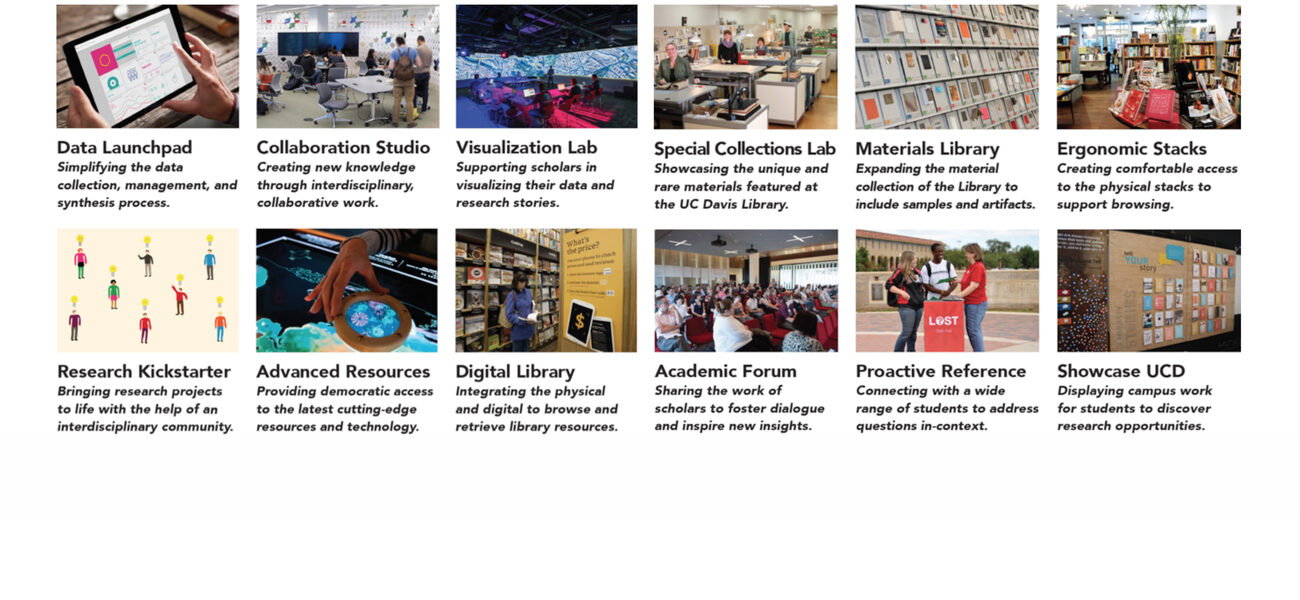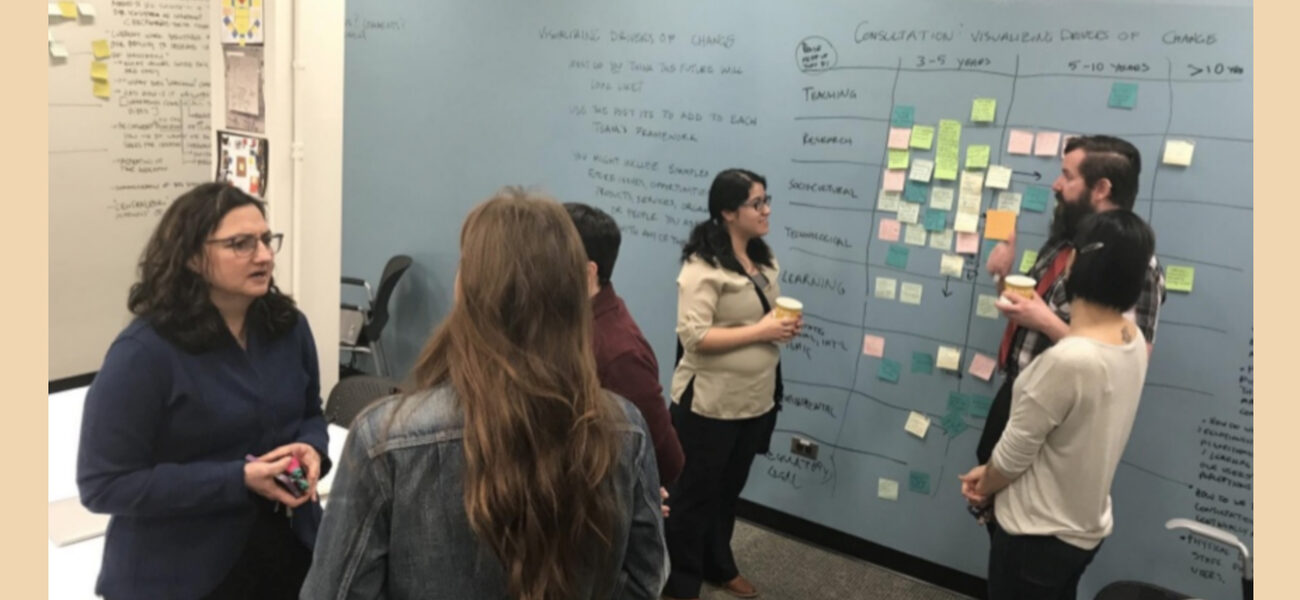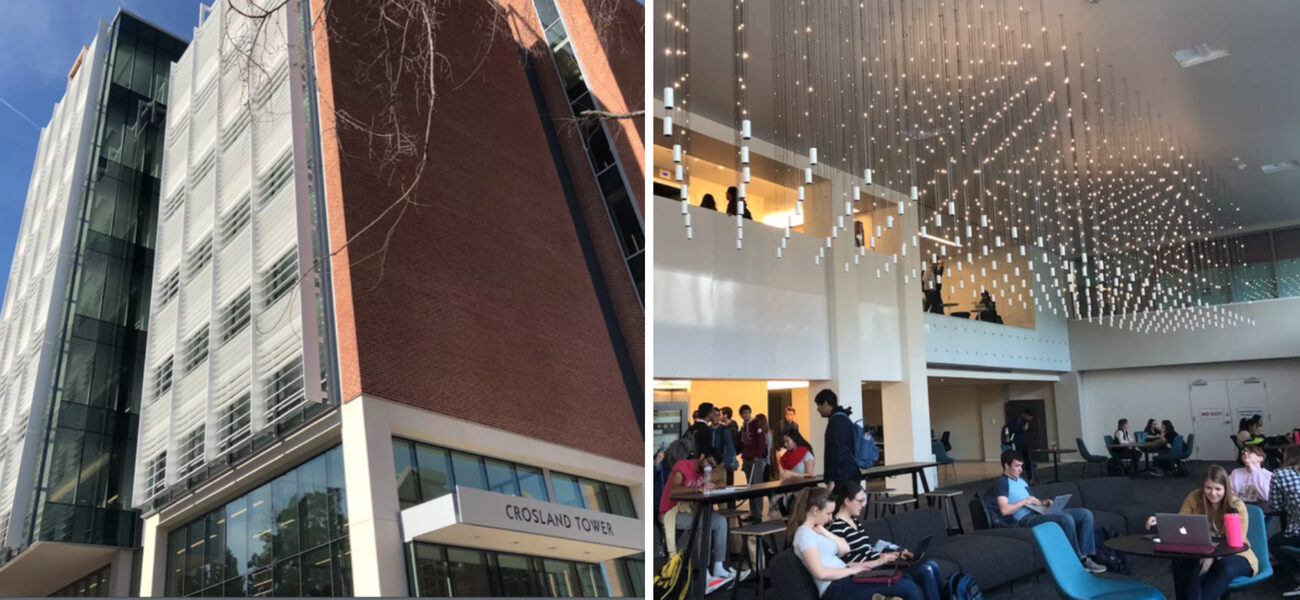If you haven’t been to a library lately, get ready for a surprise. Today’s academic libraries are not just places to get information, but to create it. To help their users succeed, institutions are transforming libraries by bringing together people, spaces, technology, and programs across a full spectrum of thought.
Amanda Wirth Lorenzo, director at brightspot, and Elliot Felix, the firm’s founder and CEO, have worked on dozens of projects transforming millions of square feet of library space. Along the way, they’ve developed a 10-step process for moving beyond stacks of books and into varied and vibrant spaces:
- Conduct internal and external research.
- Establish your vision for the future.
- Forecast your space, service, and tech needs.
- Create a playbook of ideas.
- Update services and integrate partners.
- Rationalize spaces and services across campus.
- Rationalize spaces and services within buildings.
- Identify phases for implementation.
- Identify and implement pilot projects.
- Redesign and develop the organization.
Consultation, Not Circulation
Each institution is different, but the goals of libraries are broadly similar, and the field has changed dramatically over the last 20 to 30 years. “Students are coming to the library not just to work on a paper or study for an exam, but also to work on a team project that solves a real-world problem, puts them on a career path, and builds their skills,” says Felix.
“A lot of library work used to be fairly transactional,” says Felix. “It was about checking something in and out. The good thing is that a lot of that now happens through self-serve. It happens online, and libraries can get their vendors to do it for them; for instance, buying ‘shelf-ready’ books. You can take the time that used to be spent processing things and on transactions and you can convert it into more consultative time, when you’re spending time with students and faculty to advance their research and support their classes.”
At the University of Pittsburgh, the consultants found that project-based learning was important to student success. They quote one undergraduate student who said a project-based course “felt like the first chance I had to apply what I’m learning in college to what I might do after.”
For a recent project at Georgia Tech, Lorenzo led a process of combining quantitative and qualitative research to tell a coherent story of how students and researchers were using library space and resources. The team then created an “experience model” that captured the key moments of the user experience—discovering, focusing, growing, creating, and showcasing—and identified the areas where the library could help students and faculty achieve their goals.
“This was about broadening the role that the library could play in that experience, so not just about discovering information, but supporting that into focusing, growing, and also creating, whether that’s written reports or more digital representations or even physical making, and really showcasing that work,” says Lorenzo.
With the university stakeholders, they came up with a vision statement:
We will enable people to explore the past and design the future by bringing together inspirational spaces, curated content, expert guidance, and scholarly communities.
Envisioning Possibilities
The playbook of ideas that grows out of research and vision serves as a wish list, describing possibilities from which stakeholders can pick and choose based on current and projected needs, and, of course, budgets.
As an example, Felix and Lorenzo offer a playbook from a project for the University of California, Davis, where the wish list included a visualization lab to help researchers illustrate their findings; ergonomic stacks to make browsing more comfortable; and in-context reference support that goes beyond the library to make information available at events around campus.
Often, institutions discover opportunities to centralize and coordinate services across the range of learning and research experiences.
- Many libraries are coordinating with and including student success services, such as research navigators and tech support. “Imagine a workshop on writing a paper that is co-led by the library, the quant center, and the writing center,” says Felix.
- At the University of Miami, the team found that many important services were separated organizationally, reporting to different divisions, fielding different kinds of websites. So, part of the project was bringing together online resources and imposing consistent navigation. “Most visits to a physical place begin online,” notes Felix, and digital and physical resources ideally should bolster one another.
- At the University of Wisconsin-Madison, the team worked with Engberg Anderson Architects on a plan to consolidate 17 libraries into six library hubs that are open longer hours, offer more services, and bring together staff and collections.
- The Georgia Tech library project uncovered the need for a new role—the Research Navigator—that incorporates a broader set of services to support the administrative side of research, such as complying with data and privacy provisions in a grant or meeting the requirements of an Institutional Review Board (IRB).
Working with architectural firm BNIM, Lorenzo says the planning and rethinking became a physical reality at Georgia Tech. “They created a new façade for the library that really opens it up, provides more visibility into it, expressing that activity and the welcoming environment that is inside.”
Inside, she says, are open, flexible spaces, useful for group projects, events, or just studying; quiet spaces where students can focus without interruption; and careful positioning to invite browsing and working among the stacks.
Librarians as Learning Enablers
As libraries change, lots of stereotypes are changing, too. Felix says there is definitely still a role for book stacks, but in many cases it’s more appropriate to keep stacks at 25 percent or less of a library’s people-centered space, keeping other books in high-density storage, where it costs much less to retain and protect them. For instance, a 2010 study by the Council on Library and Information Resources found that each book on an open library shelf costs $4.26 annually but just $0.86 when located off site in high-density storage. In 2014, Felix’s team worked with the authors to extend this analysis to determine the equivalent cost for each book in a robotic retrieval system on campus is $0.77. With this in mind, he suggests that “at least half the (library) space should be user space for students and faculty.”
Instead of filing books and shushing students, today’s librarians are also reaching out to market the treasures they have to offer. “Now their job incudes building relationships with faculty and consulting on the course syllabus, rather than just receiving a list of resources to put on reserve,” explains Felix, noting that virtually all libraries face the problem of service awareness.
An element of the Michigan project included “equipping their staff with the tools to shift from a collection-centric mindset to one that was more service-centric,” says Lorenzo.
That change took physical form with a special space just for staff innovation. (Because the space was in the Hatcher-Shapiro Library, it was named The Hatchery.) The staff conducted their own work analyzing how their roles were evolving, incorporating pilot projects such as new tools for citation management and coordinating the way they offer consultative services.
‘Now More Than Ever’
“You need your libraries now more than ever,” says Felix, whose first library vision was a master’s thesis contemplating the notion of a branch library located on platforms in the New York subway system.
Today’s academic library “needs to fulfill a broader role. It brings together spaces, technology, services, people to work on projects that have an impact. As learning becomes more active, that’s going to drive more and more students to the library.”
By Patricia Washburn
| Organization | Project Role |
|---|---|
|
Brightspot Strategy
|
Planning Consultants
|
|
BNIM
|
Architects
|
|
Engberg Anderson Design Partnership Inc.
|


